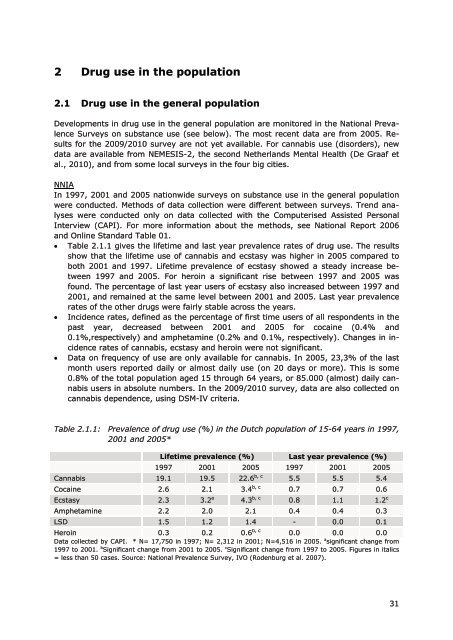The Netherlands Drug Situation 2010 - Trimbos-instituut
The Netherlands Drug Situation 2010 - Trimbos-instituut
The Netherlands Drug Situation 2010 - Trimbos-instituut
You also want an ePaper? Increase the reach of your titles
YUMPU automatically turns print PDFs into web optimized ePapers that Google loves.
2 <strong>Drug</strong> use in the population2.1 <strong>Drug</strong> use in the general populationDevelopments in drug use in the general population are monitored in the National PrevalenceSurveys on substance use (see below). <strong>The</strong> most recent data are from 2005. Resultsfor the 2009/<strong>2010</strong> survey are not yet available. For cannabis use (disorders), newdata are available from NEMESIS-2, the second <strong>Netherlands</strong> Mental Health (De Graaf etal., <strong>2010</strong>), and from some local surveys in the four big cities.NNIAIn 1997, 2001 and 2005 nationwide surveys on substance use in the general populationwere conducted. Methods of data collection were different between surveys. Trend analyseswere conducted only on data collected with the Computerised Assisted PersonalInterview (CAPI). For more information about the methods, see National Report 2006and Online Standard Table 01. Table 2.1.1 gives the lifetime and last year prevalence rates of drug use. <strong>The</strong> resultsshow that the lifetime use of cannabis and ecstasy was higher in 2005 compared toboth 2001 and 1997. Lifetime prevalence of ecstasy showed a steady increase between1997 and 2005. For heroin a significant rise between 1997 and 2005 wasfound. <strong>The</strong> percentage of last year users of ecstasy also increased between 1997 and2001, and remained at the same level between 2001 and 2005. Last year prevalencerates of the other drugs were fairly stable across the years. Incidence rates, defined as the percentage of first time users of all respondents in thepast year, decreased between 2001 and 2005 for cocaine (0.4% and0.1%,respectively) and amphetamine (0.2% and 0.1%, respectively). Changes in incidencerates of cannabis, ecstasy and heroin were not significant. Data on frequency of use are only available for cannabis. In 2005, 23,3% of the lastmonth users reported daily or almost daily use (on 20 days or more). This is some0.8% of the total population aged 15 through 64 years, or 85.000 (almost) daily cannabisusers in absolute numbers. In the 2009/<strong>2010</strong> survey, data are also collected oncannabis dependence, using DSM-IV criteria.Table 2.1.1: Prevalence of drug use (%) in the Dutch population of 15-64 years in 1997,2001 and 2005*Lifetime prevalence (%) Last year prevalence (%)1997 2001 2005 1997 2001 2005Cannabis 19.1 19.5 22.6 b, c 5.5 5.5 5.4Cocaine 2.6 2.1 3.4 b, c 0.7 0.7 0.6Ecstasy 2.3 3.2 a 4.3 b, c 0.8 1.1 1.2 cAmphetamine 2.2 2.0 2.1 0.4 0.4 0.3LSD 1.5 1.2 1.4 - 0.0 0.1Heroin 0.3 0.2 0.6 b, c 0.0 0.0 0.0Data collected by CAPI. * N= 17,750 in 1997; N= 2,312 in 2001; N=4,516 in 2005. a significant change from1997 to 2001. b Significant change from 2001 to 2005. c Significant change from 1997 to 2005. Figures in italics= less than 50 cases. Source: National Prevalence Survey, IVO (Rodenburg et al. 2007).31




